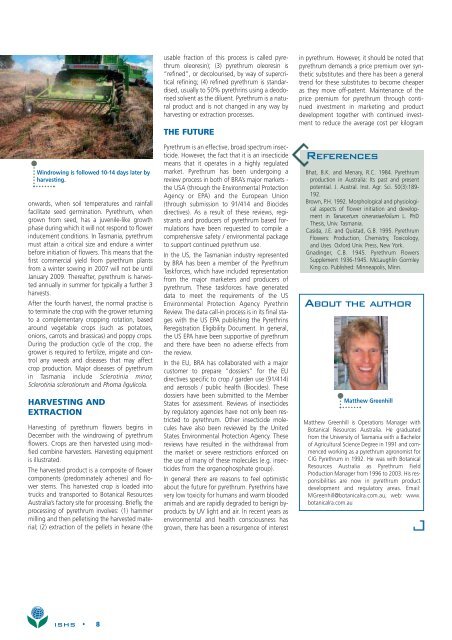Chronica - Acta Horticulturae
Chronica - Acta Horticulturae
Chronica - Acta Horticulturae
Create successful ePaper yourself
Turn your PDF publications into a flip-book with our unique Google optimized e-Paper software.
Windrowing is followed 10-14 days later by<br />
harvesting.<br />
onwards, when soil temperatures and rainfall<br />
facilitate seed germination. Pyrethrum, when<br />
grown from seed, has a juvenile-like growth<br />
phase during which it will not respond to flower<br />
inducement conditions. In Tasmania, pyrethrum<br />
must attain a critical size and endure a winter<br />
before initiation of flowers. This means that the<br />
first commercial yield from pyrethrum plants<br />
from a winter sowing in 2007 will not be until<br />
January 2009. Thereafter, pyrethrum is harvested<br />
annually in summer for typically a further 3<br />
harvests.<br />
After the fourth harvest, the normal practise is<br />
to terminate the crop with the grower returning<br />
to a complementary cropping rotation, based<br />
around vegetable crops (such as potatoes,<br />
onions, carrots and brassicas) and poppy crops.<br />
During the production cycle of the crop, the<br />
grower is required to fertilize, irrigate and control<br />
any weeds and diseases that may affect<br />
crop production. Major diseases of pyrethrum<br />
in Tasmania include Sclerotinia minor,<br />
Sclerotinia sclerotiorum and Phoma ligulicola.<br />
HARVESTING AND<br />
EXTRACTION<br />
Harvesting of pyrethrum flowers begins in<br />
December with the windrowing of pyrethrum<br />
flowers. Crops are then harvested using modified<br />
combine harvesters. Harvesting equipment<br />
is illustrated.<br />
The harvested product is a composite of flower<br />
components (predominately achenes) and flower<br />
stems. This harvested crop is loaded into<br />
trucks and transported to Botanical Resources<br />
Australia’s factory site for processing. Briefly, the<br />
processing of pyrethrum involves: (1) hammer<br />
milling and then pelletising the harvested material;<br />
(2) extraction of the pellets in hexane (the<br />
usable fraction of this process is called pyrethrum<br />
oleoresin); (3) pyrethrum oleoresin is<br />
“refined”, or decolourised, by way of supercritical<br />
refining; (4) refined pyrethrum is standardised,<br />
usually to 50% pyrethrins using a deodorised<br />
solvent as the diluent. Pyrethrum is a natural<br />
product and is not changed in any way by<br />
harvesting or extraction processes.<br />
THE FUTURE<br />
Pyrethrum is an effective, broad spectrum insecticide.<br />
However, the fact that it is an insecticide<br />
means that it operates in a highly regulated<br />
market. Pyrethrum has been undergoing a<br />
review process in both of BRA’s major markets -<br />
the USA (through the Environmental Protection<br />
Agency or EPA) and the European Union<br />
(through submission to 91/414 and Biocides<br />
directives). As a result of these reviews, registrants<br />
and producers of pyrethrum based formulations<br />
have been requested to compile a<br />
comprehensive safety / environmental package<br />
to support continued pyrethrum use.<br />
In the US, the Tasmanian industry represented<br />
by BRA has been a member of the Pyrethrum<br />
Taskforces, which have included representation<br />
from the major marketers and producers of<br />
pyrethrum. These taskforces have generated<br />
data to meet the requirements of the US<br />
Environmental Protection Agency Pyrethrin<br />
Review. The data call-in process is in its final stages<br />
with the US EPA publishing the Pyrethrins<br />
Reregistration Eligibility Document. In general,<br />
the US EPA have been supportive of pyrethrum<br />
and there have been no adverse effects from<br />
the review.<br />
In the EU, BRA has collaborated with a major<br />
customer to prepare “dossiers” for the EU<br />
directives specific to crop / garden use (91/414)<br />
and aerosols / public health (Biocides). These<br />
dossiers have been submitted to the Member<br />
States for assessment. Reviews of insecticides<br />
by regulatory agencies have not only been restricted<br />
to pyrethrum. Other insecticide molecules<br />
have also been reviewed by the United<br />
States Environmental Protection Agency. These<br />
reviews have resulted in the withdrawal from<br />
the market or severe restrictions enforced on<br />
the use of many of these molecules (e.g. insecticides<br />
from the organophosphate group).<br />
In general there are reasons to feel optimistic<br />
about the future for pyrethrum. Pyrethrins have<br />
very low toxicity for humans and warm blooded<br />
animals and are rapidly degraded to benign byproducts<br />
by UV light and air. In recent years as<br />
environmental and health consciousness has<br />
grown, there has been a resurgence of interest<br />
in pyrethrum. However, it should be noted that<br />
pyrethrum demands a price premium over synthetic<br />
substitutes and there has been a general<br />
trend for these substitutes to become cheaper<br />
as they move off-patent. Maintenance of the<br />
price premium for pyrethrum through continued<br />
investment in marketing and product<br />
development together with continued investment<br />
to reduce the average cost per kilogram<br />
REFERENCES<br />
Bhat, B.K. and Menary, R.C. 1984. Pyrethrum<br />
production in Australia: Its past and present<br />
potential. J. Austral. Inst. Agr. Sci. 50(3):189-<br />
192.<br />
Brown, P.H. 1992. Morphological and physiological<br />
aspects of flower initiation and development<br />
in Tanacetum cinerariaefolium L. PhD<br />
Thesis, Univ. Tasmania.<br />
Casida, J.E. and Quistad, G.B. 1995. Pyrethrum<br />
Flowers: Production, Chemistry, Toxicology,<br />
and Uses. Oxford Univ. Press, New York.<br />
Gnadinger, C.B. 1945. Pyrethrum Flowers<br />
Supplement 1936-1945. McLaughlin Gormley<br />
King co. Published: Minneapolis, Minn.<br />
ABOUT THE AUTHOR<br />
Matthew Greenhill<br />
Matthew Greenhill is Operations Manager with<br />
Botanical Resources Australia. He graduated<br />
from the University of Tasmania with a Bachelor<br />
of Agricultural Science Degree in 1991 and commenced<br />
working as a pyrethrum agronomist for<br />
CIG Pyrethrum in 1992. He was with Botanical<br />
Resources Australia as Pyrethrum Field<br />
Production Manager from 1996 to 2003. His responsibilities<br />
are now in pyrethrum product<br />
development and regulatory areas. Email:<br />
MGreenhill@botanicalra.com.au, web: www.<br />
botanicalra.com.au<br />
ISHS • 8
















